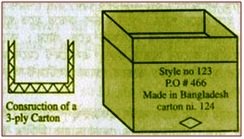Garments are delivered to the buyer in cartons. Garments in poly bags are kept in a carton box as per instruction of the buyer. Loading cartons with garments are called packaging. Garments are loaded in cartons with a designated proportion of size and color. This proportion is called assortment. Maintaining the designated assortment is very important. It shows what sizes and colors should go with each carton. It is the requirement of a store at the buyer’s end for which the package is designated.

Carton Box for Garments Packing

Wrong assortment of packing may lead to rejection of the consignment or a discount from the factory. To avoid wrong packaging, we should closely check all packing detail, of course, having our clear concept such as packing material, sizes, bar-code sticker, label position etc. that will help you to avoid claim after shipment.
Carton is the most important container for shipment of the goods. Buyer usually gives written instruction as to the construction of the cartons. As per buyer requirement, there should be a shipping mark both sides of carton box where exist bar-code sticker and other shipping information. Cartons are made of multiple plies of the special type of paper. The respective buyer could fix three plies, five plies or seven plies (Normal/All liner/High GSM) quality carton boxes. Some buyer also likes to use an additional ply board to increase protection of their goods.
Cartons should be adequately strong so that they can carry the garments to the buyer in far off countries without getting damaged. Loaded cartons are bound with PP strapping. For FCL shipment PP strapping is not required, but for LCL cargo sometimes PP strapping is mandatory, but now a day’s maximum buyer is not willing to use PP strapping due to an environmental issue.
Inner cartons are smaller that outer carton boxes. An outer carton often contains a number of inner cartons. For example, an outer carton must contain forty shirts and they should be divided into four inner cartons. So, each inner carton must hold ten shirts, and there should be four inner cartons in the main carton. This way of packaging keeps the garment safe and away from damage. Packaging is also a manual and labor-intensive work. However, simple tools are available to enhance productivity.
You may like: SOP of Packing Operator




Leave a Reply
You must be logged in to post a comment.